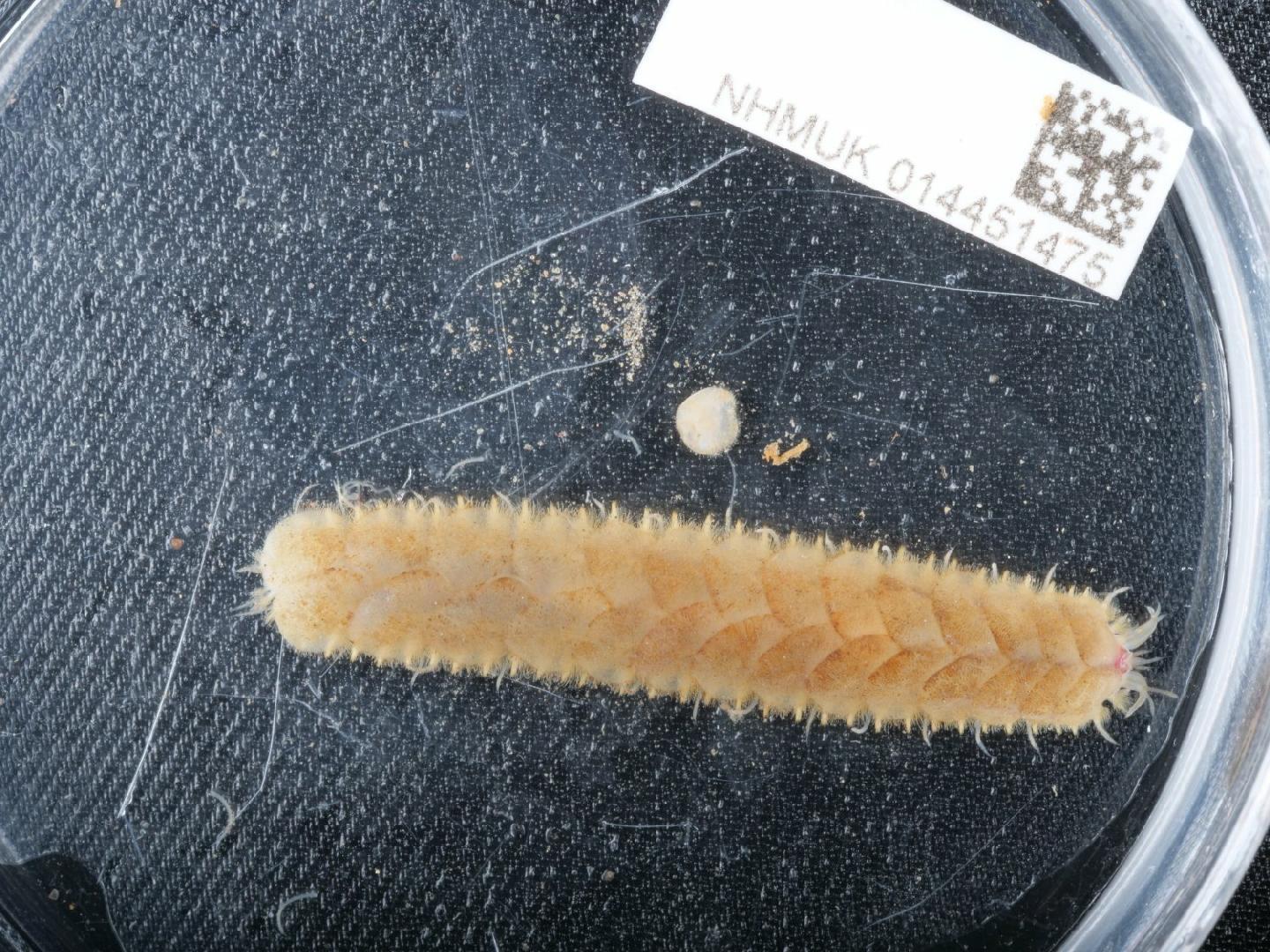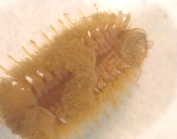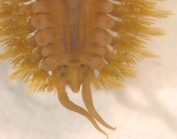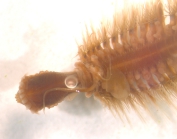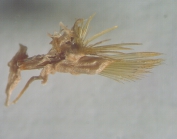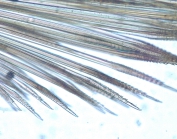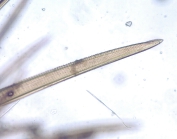Deep-Sea taxon details
Gattyana cirrhosa (Pallas, 1766)
130749 (urn:lsid:marinespecies.org:taxname:130749)
accepted
Species
marine, brackish, fresh, terrestrial
recent only
(of ) Pallas, P.S. (1766) Miscellanea zoologica. Quibus novae imprimis atque obscurae animalium species describuntur et observationibus iconibusque illustrantur. Petrum van Cleef. Hagí Comitum., xii + 224 pp.;14 pls., available online at https://archive.org/details/pspallasmedicina00pall
page(s): 95-97, plate VIII figs. 3-6 [details]
page(s): 95-97, plate VIII figs. 3-6 [details]
Distribution This species is very abundant at the Oyster Ground, where it forms a substantial part of the infaunal biomass. G. cirrhosa...
Distribution This species is very abundant at the Oyster Ground, where it forms a substantial part of the infaunal biomass. G. cirrhosa also occurs in the Delta area (Grevelingenmeer, Ooster- and Westerschelde). The species is (almost) absent from the Southern Bight and the Wadden Sea. [details]
Read, G.; Fauchald, K. (Ed.) (2024). World Polychaeta Database. Gattyana cirrhosa (Pallas, 1766). Accessed through: Glover, A.G.; Higgs, N.; Horton, T. (2024) World Register of Deep-Sea species (WoRDSS) at: https://www.marinespecies.org/DeepSea/aphia.php?p=taxdetails&id=130749 on 2024-04-19
Glover, A.G.; Higgs, N.; Horton, T. (2024). World Register of Deep-Sea species (WoRDSS). Gattyana cirrhosa (Pallas, 1766). Accessed at: https://marinespecies.org/deepsea/aphia.php?p=taxdetails&id=130749 on 2024-04-19
Date
action
by
original description
(of ) Pallas, P.S. (1766) Miscellanea zoologica. Quibus novae imprimis atque obscurae animalium species describuntur et observationibus iconibusque illustrantur. Petrum van Cleef. Hagí Comitum., xii + 224 pp.;14 pls., available online at https://archive.org/details/pspallasmedicina00pall
page(s): 95-97, plate VIII figs. 3-6 [details]
context source (Deepsea) Census of Marine Life (2012). SYNDEEP: Towards a first global synthesis of biodiversity, biogeography and ecosystem function in the deep sea. Unpublished data (datasetID: 38), available online at http://www.comlsecretariat.org/wp-content/uploads/2010/06/SYNDEEP-Towards-a-first-global-synthesis-of-biodiversity-biogeography-and-ecosystem-function-in-the-deep-sea-Eva-Ramirez-Llodra-et-al..pdf [details]
context source (Schelde) Maris, T.; Beauchard, O.; Van Damme, S.; Van den Bergh, E.; Wijnhoven, S.; Meire, P. (2013). Referentiematrices en Ecotoopoppervlaktes Annex bij de Evaluatiemethodiek Schelde-estuarium Studie naar “Ecotoopoppervlaktes en intactness index”. <em>Monitor Taskforce Publication Series, 2013-01. NIOZ: Yerseke.</em> 35 pp. (look up in IMIS) [details]
context source (BeRMS 2020) Bio-environmental research group; Institute of Agricultural and Fisheries research (ILVO), Belgium; (2015): Macrobenthos monitoring in function of the Water Framework Directive in the period 2007-2009. [details]
basis of record Bellan, G. (2001). Polychaeta, <i>in</i>: Costello, M.J. <i>et al.</i> (Ed.) (2001). European register of marine species: a check-list of the marine species in Europe and a bibliography of guides to their identification. <em>Collection Patrimoines Naturels.</em> 50: 214-231. (look up in IMIS) [details]
additional source Fauchald, K. (1977). The polychaete worms, definitions and keys to the orders, families and genera. <em>Natural History Museum of Los Angeles County: Los Angeles, CA (USA), Science Series.</em> 28:1-188., available online at http://www.vliz.be/imisdocs/publications/123110.pdf [details]
redescription Jirkov, I.A. (2001). [Polychaeta of the Arctic Ocean] (In Russian) Polikhety severnogo Ledovitogo Okeana. Yanus-K Press, Moscow, 632 pp., available online at https://www.researchgate.net/publication/259865957_Jirkov_2001_Polychaeta_of_the_North_Polar_Basin [details] Available for editors
redescription Pettibone, Marian H. (1963). Marine polychaete worms of the New England region. I. Aphroditidae through Trochochaetidae. <i>Bulletin of the United States National Museum</i>. 227(1): 1-356., available online at https://www.biodiversitylibrary.org/page/7870746
page(s): 28-29, figure 5b-d [details]
page(s): 95-97, plate VIII figs. 3-6 [details]
context source (Deepsea) Census of Marine Life (2012). SYNDEEP: Towards a first global synthesis of biodiversity, biogeography and ecosystem function in the deep sea. Unpublished data (datasetID: 38), available online at http://www.comlsecretariat.org/wp-content/uploads/2010/06/SYNDEEP-Towards-a-first-global-synthesis-of-biodiversity-biogeography-and-ecosystem-function-in-the-deep-sea-Eva-Ramirez-Llodra-et-al..pdf [details]
context source (Schelde) Maris, T.; Beauchard, O.; Van Damme, S.; Van den Bergh, E.; Wijnhoven, S.; Meire, P. (2013). Referentiematrices en Ecotoopoppervlaktes Annex bij de Evaluatiemethodiek Schelde-estuarium Studie naar “Ecotoopoppervlaktes en intactness index”. <em>Monitor Taskforce Publication Series, 2013-01. NIOZ: Yerseke.</em> 35 pp. (look up in IMIS) [details]
context source (BeRMS 2020) Bio-environmental research group; Institute of Agricultural and Fisheries research (ILVO), Belgium; (2015): Macrobenthos monitoring in function of the Water Framework Directive in the period 2007-2009. [details]
basis of record Bellan, G. (2001). Polychaeta, <i>in</i>: Costello, M.J. <i>et al.</i> (Ed.) (2001). European register of marine species: a check-list of the marine species in Europe and a bibliography of guides to their identification. <em>Collection Patrimoines Naturels.</em> 50: 214-231. (look up in IMIS) [details]
additional source Fauchald, K. (1977). The polychaete worms, definitions and keys to the orders, families and genera. <em>Natural History Museum of Los Angeles County: Los Angeles, CA (USA), Science Series.</em> 28:1-188., available online at http://www.vliz.be/imisdocs/publications/123110.pdf [details]
redescription Jirkov, I.A. (2001). [Polychaeta of the Arctic Ocean] (In Russian) Polikhety severnogo Ledovitogo Okeana. Yanus-K Press, Moscow, 632 pp., available online at https://www.researchgate.net/publication/259865957_Jirkov_2001_Polychaeta_of_the_North_Polar_Basin [details] Available for editors
redescription Pettibone, Marian H. (1963). Marine polychaete worms of the New England region. I. Aphroditidae through Trochochaetidae. <i>Bulletin of the United States National Museum</i>. 227(1): 1-356., available online at https://www.biodiversitylibrary.org/page/7870746
page(s): 28-29, figure 5b-d [details]
 Present
Present  Inaccurate
Inaccurate  Introduced: alien
Introduced: alien  Containing type locality
Containing type locality
From other sources
Biology Breeding probably takes place in spring (March-June) and the larvae develop in the water column. The species spawns several times during its life. It can reach an age of at least 4-5 years. In the subtidal parts of the area, G. cirrhosa is almost exclusively found in the tubes of the polychaete Chaetopterus variopedatus. Other studies have recorded the species from (empty) tubes of other polychaetes such as Lagis koreni and Amphitrite johnstoni, and in Arenicola burrows. G. cirrosa, like all polynoids, is considered a predatory carnivore. Small crustaceans, echinoderms, polychaetes, gastropods, sponges and hydroids have been mentioned as prey items. (Hartmann-Schröder, 1971; Wolff, 1973; Curtis, 1977; Fauchald & Jumars, 1979; Hayward & Ryland, 1990). [details]
Distribution This species is very abundant at the Oyster Ground, where it forms a substantial part of the infaunal biomass. G. cirrhosa also occurs in the Delta area (Grevelingenmeer, Ooster- and Westerschelde). The species is (almost) absent from the Southern Bight and the Wadden Sea. [details]
Habitat G. cirrhosa shows a preference for the muddier types of sediment as found in the Oyster Ground. [details]
Morphology This species has a flattened body that is oval in outline. lt is composed of up to 38 segrnents and reaches 40 mm in length. The dorsal surface is covered with fifteen pairs of soft scales (elytra). These elytra are covered with minute spines and have a fringe of papillae along the outer edge. The head bears four eyes, one median and two lateral antennae. The elytra have a distinct dark spot in the centre (Hartmann-Schröder, 1971; Hayward & Ryland, 1990). [details]
To Barcode of Life (34 barcodes)
To Biodiversity Heritage Library (8 publications)
To European Nucleotide Archive (ENA)
To GenBank (24 nucleotides; 20 proteins)
To NHMUK collection (Gattyana cirrhosa (Pallas, 1766); NON-TYPE; NHMUK:ecatalogue:9474021)
To PESI
To The Arctic Traits Database (46 traits)
To Yale Peabody Museum of Natural History (YPM IZ 096990)
Wikipedia
To Biodiversity Heritage Library (8 publications)
To European Nucleotide Archive (ENA)
To GenBank (24 nucleotides; 20 proteins)
To NHMUK collection (Gattyana cirrhosa (Pallas, 1766); NON-TYPE; NHMUK:ecatalogue:9474021)
To PESI
To The Arctic Traits Database (46 traits)
To Yale Peabody Museum of Natural History (YPM IZ 096990)
Wikipedia

